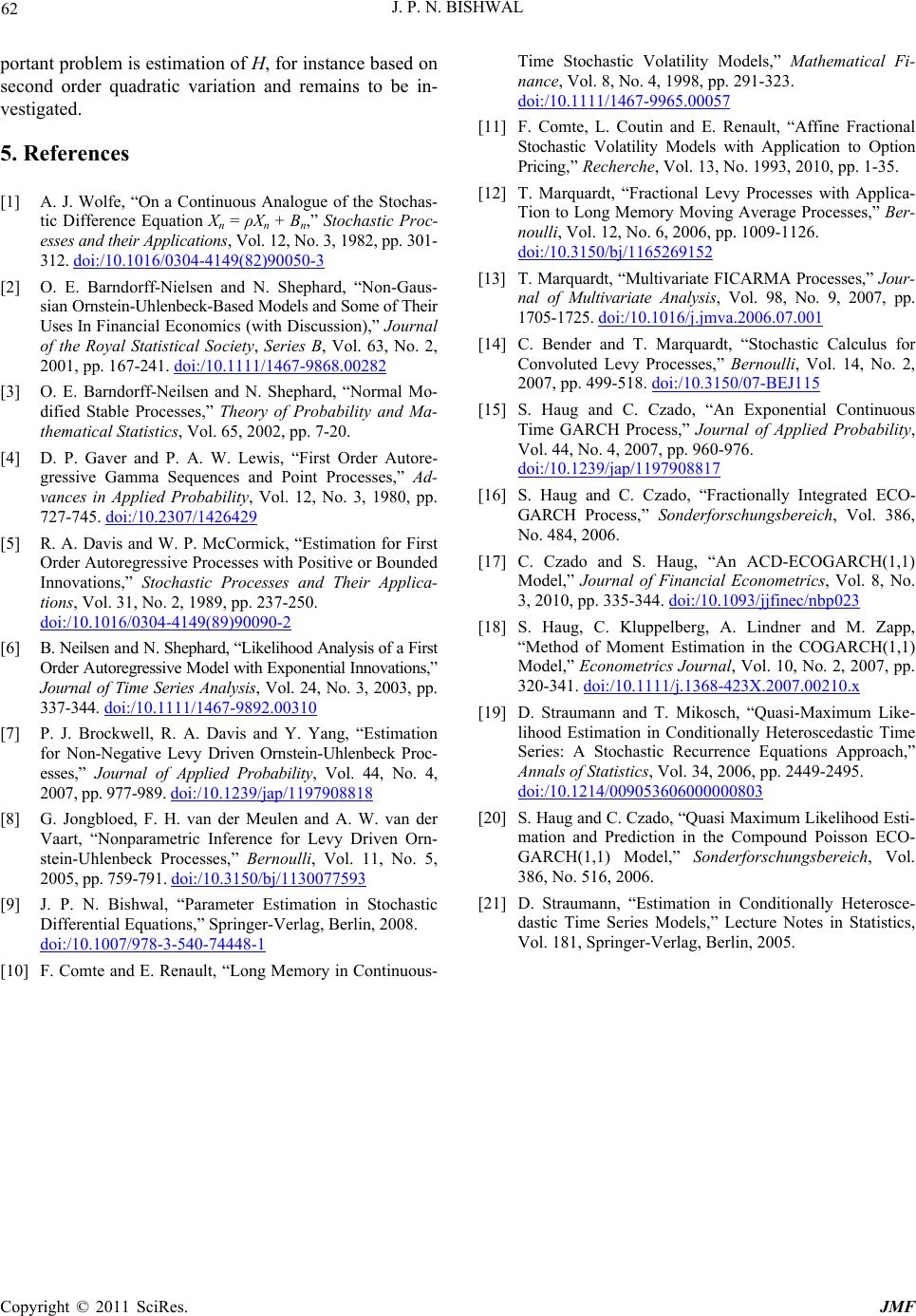
J. P. N. BISHWAL
Copyright © 2011 SciRes. JMF
62
portant problem is estimation of H, for instance based on
second order quadratic variation and remains to be in-
vestigated.
5. References
[1] A. J. Wolfe, “On a Continuous Analogue of the Stochas-
tic Difference Equation Xn = ρXn + Bn,” Stochastic Proc-
esses and their Applications, Vol. 12, No. 3, 1982, pp. 301-
312. doi:/10.1016/0304-4149(82)90050-3
[2] O. E. Barndorff-Nielsen and N. Shephard, “Non-Gaus-
sian Ornstein-Uhlenbeck-Based Models and Some of Their
Uses In Financial Economics (with Discussion),” Journal
of the Royal Statistical Society, Series B, Vol. 63, No. 2,
2001, pp. 167-241. doi:/10.1111/1467-9868.00282
[3] O. E. Barndorff-Neilsen and N. Shephard, “Normal Mo-
dified Stable Processes,” Theory of Probability and Ma-
thematical Statistics, Vol. 65, 2002, pp. 7-20.
[4] D. P. Gaver and P. A. W. Lewis, “First Order Autore-
gressive Gamma Sequences and Point Processes,” Ad-
vances in Applied Probability, Vol. 12, No. 3, 1980, pp.
727-745. doi:/10.2307/1426429
[5] R. A. Davis and W. P. McCormick, “Estimation for First
Order Autoregressive Processes with Positive or Bounded
Innovations,” Stochastic Processes and Their Applica-
tions, Vol. 31, No. 2, 1989, pp. 237-250.
doi:/10.1016/0304-4149(89)90090-2
[6] B. Neilsen and N. Shephard, “Likelihood Analysis of a First
Order Autoregressive Model with Exponential Innovations,”
Journal of Time Series Analysis, Vol. 24, No. 3, 2003, pp.
337-344. doi:/10.1111/1467-9892.00310
[7] P. J. Brockwell, R. A. Davis and Y. Yang, “Estimation
for Non-Negative Levy Driven Ornstein-Uhlenbeck Proc-
esses,” Journal of Applied Probability, Vol. 44, No. 4,
2007, pp. 977-989. doi:/10.1239/jap/1197908818
[8] G. Jongbloed, F. H. van der Meulen and A. W. van der
Vaart, “Nonparametric Inference for Levy Driven Orn-
stein-Uhlenbeck Processes,” Bernoulli, Vol. 11, No. 5,
2005, pp. 759-791. doi:/10.3150/bj/1130077593
[9] J. P. N. Bishwal, “Parameter Estimation in Stochastic
Differential Equations,” Springer-Verlag, Berlin, 2008.
doi:/10.1007/978-3-540-74448-1
[10] F. Comte and E. Renault, “Long Memory in Continuous-
Time Stochastic Volatility Models,” Mathematical Fi-
nance, Vol. 8, No. 4, 1998, pp. 291-323.
doi:/10.1111/1467-9965.00057
[11] F. Comte, L. Coutin and E. Renault, “Affine Fractional
Stochastic Volatility Models with Application to Option
Pricing,” Recherche, Vol. 13, No. 1993, 2010, pp. 1-35.
[12] T. Marquardt, “Fractional Levy Processes with Applica-
Tion to Long Memory Moving Average Processes,” Ber-
noulli, Vol. 12, No. 6, 2006, pp. 1009-1126.
doi:/10.3150/bj/1165269152
[13] T. Marquardt, “Multivariate FICARMA Processes,” Jour-
nal of Multivariate Analysis, Vol. 98, No. 9, 2007, pp.
1705-1725. doi:/10.1016/j.jmva.2006.07.001
[14] C. Bender and T. Marquardt, “Stochastic Calculus for
Convoluted Levy Processes,” Bernoulli, Vol. 14, No. 2,
2007, pp. 499-518. doi:/10.3150/07-BEJ115
[15] S. Haug and C. Czado, “An Exponential Continuous
Time GARCH Process,” Journal of Applied Probability,
Vol. 44, No. 4, 2007, pp. 960-976.
doi:/10.1239/jap/1197908817
[16] S. Haug and C. Czado, “Fractionally Integrated ECO-
GARCH Process,” Sonderforschungsbereich, Vol. 386,
No. 484, 2006.
[17] C. Czado and S. Haug, “An ACD-ECOGARCH(1,1)
Model,” Journal of Financial Econometrics, Vol. 8, No.
3, 2010, pp. 335-344. doi:/10.1093/jjfinec/nbp023
[18] S. Haug, C. Kluppelberg, A. Lindner and M. Zapp,
“Method of Moment Estimation in the COGARCH(1,1)
Model,” Econometrics Journal, Vol. 10, No. 2, 2007, pp.
320-341. doi:/10.1111/j.1368-423X.2007.00210.x
[19] D. Straumann and T. Mikosch, “Quasi-Maximum Like-
lihood Estimation in Conditionally Heteroscedastic Time
Series: A Stochastic Recurrence Equations Approach,”
Annals of Statistics, Vol. 34, 2006, pp. 2449-2495.
doi:/10.1214/009053606000000803
[20] S. Haug and C. Czado, “Quasi Maximum Likelihood Esti-
mation and Prediction in the Compound Poisson ECO-
GARCH(1,1) Model,” Sonderforschungsbereich, Vol.
386, No. 516, 2006.
[21] D. Straumann, “Estimation in Conditionally Heterosce-
dastic Time Series Models,” Lecture Notes in Statistics,
Vol. 181, Springer-Verlag, Berlin, 2005.